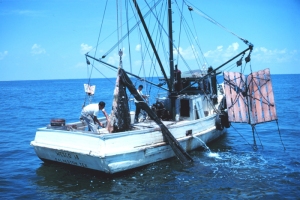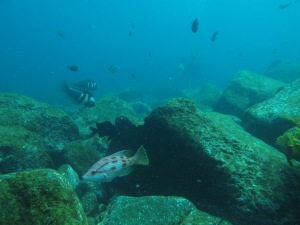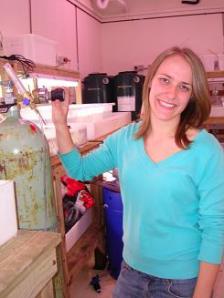This is the thi rd article in the series that I’m writing for a Chinese magazine targeting wildlife conservation. As you may guess, they started with Panda conservation, so the magazine is called Giant Panda, but they are running a series on exploitation of natural resources. So far I have covered overfishing, trawling and longline fishing. In this current article we discuss the interaction between fishing and climate change. I say we, because this article was led by Charlee Corra, a postgraduate student of mine. Charlee really deserves the credit for this one!
rd article in the series that I’m writing for a Chinese magazine targeting wildlife conservation. As you may guess, they started with Panda conservation, so the magazine is called Giant Panda, but they are running a series on exploitation of natural resources. So far I have covered overfishing, trawling and longline fishing. In this current article we discuss the interaction between fishing and climate change. I say we, because this article was led by Charlee Corra, a postgraduate student of mine. Charlee really deserves the credit for this one!
The first article in this series discussed the effects of overfishing and how it causes degradation to the environment. However, changes to the environment also affect fisheries and their sustainability. In any ecosystem, the survival of a species is dependent on its ability to grow to maturity and reproduce, which is in turn dependent on many factors such as environmental conditions that support healthy physiological functioning. Temperature, salinity, and water quality are all examples of integral abiotic factors that can have the power to support life or pose a serious threat. Global climate change is rapidly altering these environmental conditions, and thus altering marine communities in a way that scientists, fishermen, fisheries managers, and policy makers must understand in order to predict future stocks and improve sustainable practices
How the environment affects plants and animals
Physiology: Marine organisms differ widely in their tolerance of environmental conditions. Some animals can survive better under stress than others. These differences in biological responses determine where an organism can live. For example, in the intertidal zone temperature sets the upper limits of species distributions such that barnacles, mussels or oysters with a greater heat tolerance live higher on the shore than those with a lower tolerance. While almost every organism has the ability to withstand heat stress to varying degrees, most organisms are also adapted to the temperatures in their particular habitat. Thus, many species, and even populations, have different thermal limits beyond which survival is brought into question. As an extreme example, imagine that you grew up in the polar regions and summer for you only gets as hot as, say, 10°C and you were put in the desert in summer – you would be above your thermal tolerance and likely would die.
The water chemistry of our oceans also heavily affects physiological functions. Calcifying organisms, such as corals, oysters, mussels, and some crustaceans, rely on specific levels of CO2 (usually low) and several other chemical compounds (usually high) in order to induce the chemical reaction that allows them to make their skeletons and shells. Changes to the water’s chemistry can compromise the structural integrity of these essential parts. Of particular concern is that constant and increasing CO2 emissions are causing more CO2 to dissolve into the ocean, causing Ocean Acidification (OA). OA is already making it difficult for shelled organisms to make their shells in some parts of the ocean! You can do a small experiment to demonstrate this effect: put a small seashell or piece of egg shell into a glass of an acidic liquid like Cola or vinegar and watch it slowly dissolve (this can take a day or two).
Climate change and long-term climate shifts: Climate fluctuates and changes naturally across many different time scales from seasonal to multi-decadal and millennial. However, in the last two centuries industrial activity has begun to influence these cycles, mostly because of emissions of greenhouse gases such as CO2 into the atmosphere. Of particular concern is that in addition to causing OA this CO2 also causes the earth’s atmosphere to warm, in turn warming the ocean. Unless something is done to change this trajectory, CO2 levels will continue to rise, negative effects on the environment will become stronger, and the impacts on marine habitats and communities will become more visible.
Shifts in distribution of plants and animals: As environmental conditions change, and especially as oceans warm up, many species are predicted to move poleward to higher latitudes to live in more optimal conditions. These range shifts are not always consistent or predictable among organisms or across regions due to complex ecological interactions with other physical and biological factors such as currents and larval dispersal, competitors and predators. Importantly, as the distributions of different species change, the balance of ecosystems is upset and their function is degraded.
Just as with other species, climate change will invariably impact fish populations and dynamics. For example, fish populations may either get smaller where they currently are or move to a new area. Adjusting fishing practices and quotas to these changes is essential for the future of sustainable fisheries.

Photo courtesy of the NOAA photo library (www.photolib.noaa.gov) Photographer: Robert K. Brigham
Effects of climate change on fisheries
Range shifts represent a huge threat to the productivity and success of fisheries, especially when they occur to economically and socially important species. In addition to losing an important species as its range shifts poleward, fisheries may be further affected by the opening of a gap in the ecosystem that can become occupied by a new species. This ultimately changes the structure and function of the ecosystem, potentially reducing the productivity of not only that single fishery but also the ecosystem overall.
In addition to range shifts, decreases in abundance of fish may also occur simultaneously. For example, warming has already caused decreases in populations of Norwegian Cod, leading to a less sustainable fishery. In such cases, the fishermen must either change to another fishery or risk damage to the fishery, degradation of the ecosystem and going out of business.
Together, the combination of range shifts and declining abundance has the potential to be devastating to fisheries if vulnerable fish stocks are fished at the same intensity. Particularly sensitive fish stocks could easily collapse under these combined pressures. Considering that over 80% of the world’s fisheries are either already fully fished or over-exploited, collapses will become more likely under future conditions. However, armed with more accurate knowledge of how fished populations will be impacted, fishing regulations could be fine-tuned to protect the viability of fished species and avoid such a bleak future.
Predicting future stocks
Knowing that these issues exist, a lot of research is currently being done to predict the trajectory of future fish stocks and assist in managing fisheries in a more sustainable way. Because we are trying to predict what will happen in the future, one of the common techniques is to use computer-generated models which use complex calculations based on as many environmental and biological variables as possible to predict the effects of climate change on fish populations. These models take into account the physiological effects of climate change (mentioned above) on the targeted species to predict parameters such as growth, survival, and reproductive output to determine the future supply of adults. Then, in combination with experiments to test the outputs of these models, managers and policy makers decide how many and what type of fish can be caught annually to avoid depleting populations but also to maximize profits and food security. Importantly, these models can, if used properly, help managers prepare for the future of fisheries and to hopefully avoid more fisheries collapsing. However, it is extremely important to remember that predictions are not certainties and models, while very powerful tools, are far from perfect. There will always be variability across regions and habitats due to the interaction of many different factors and projections might represent some outcomes but not all.
It is important to remember that we can formulate all the regulations that want, but unless we are also simultaneously making an effort to decrease or mitigate the impacts of a changing climate on the ocean and its ecosystems, fisheries will continue to decline. The ocean is an important source of food for humans. In many countries seafood is a way of life. Many smaller communities rely exclusively on fish and other marine organisms for protein. Therefore, it is important for everyone to understand how climate change will impact on the ability of marine organisms to survive because our fate is inextricably intertwined with that of the marine environment.











